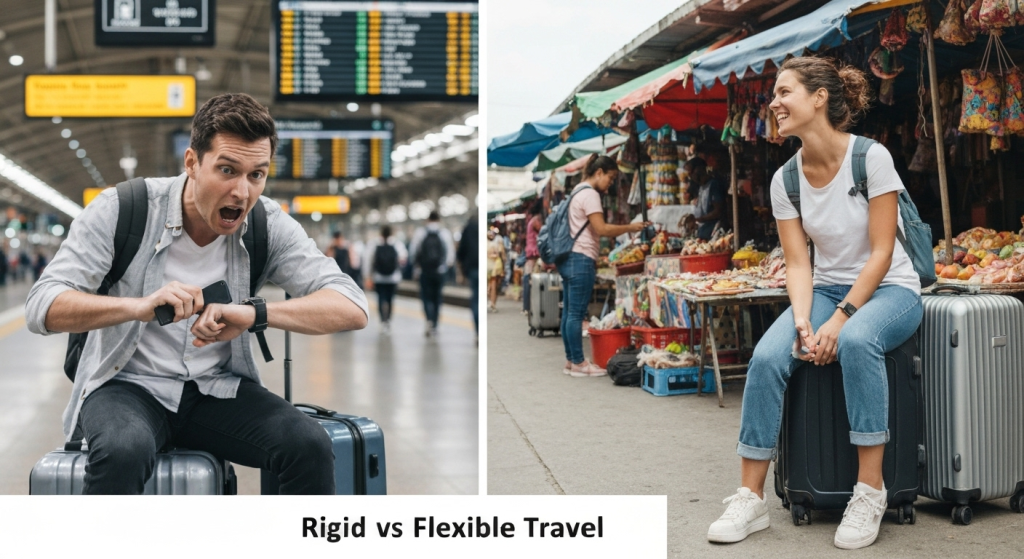Travel planning can feel overwhelming. Most people spend weeks creating detailed schedules that fall apart the moment they arrive at their destination. After five years of exploring over 30 countries, I’ve learned something important: the best trips happen when you plan less, not more.
My name is Mahnoor Farooq, and I’ve been a professional travel consultant for five years. During this time, I’ve helped hundreds of travelers discover the power of flexible itineraries. What started as a personal preference became my expertise after countless trips taught me that rigid planning often kills the magic of travel.
What Is a Flexible Itinerary?

A flexible itinerary is a travel plan that includes your must-see destinations and activities while leaving plenty of room for spontaneous discoveries. Instead of scheduling every hour, you focus on key experiences and allow natural flow between activities.
Think of it like a skeleton rather than a full body. You have the bones of your trip in place, but the details fill themselves in as you go. This approach gives you structure without the stress of sticking to unrealistic timelines.
Key Components of Flexible Travel Planning
Core Destinations: Choose 2-3 main places you absolutely want to visit. These become your anchor points.
Buffer Time: Add extra days between major activities. This prevents rushing and allows for unexpected discoveries.
Open Blocks: Schedule large chunks of free time rather than hourly activities.
Backup Options: Research alternative activities in case your first choice doesn’t work out.
During my trip to Italy last year, I planned to spend two days in Florence. A local recommended a small village called Montepulciano. Because I had flexible time blocks, I could extend my stay and explore this hidden gem. This became the highlight of my entire trip.
Why Flexible Itineraries Work Better

Traditional detailed planning assumes everything will go according to schedule. Real travel doesn’t work this way. Weather changes, attractions close unexpectedly, and you discover places that weren’t in any guidebook.
The Problems with Rigid Planning
Rigid itineraries create several issues that flexible planning solves:
Time Pressure: When every hour is scheduled, you feel rushed even during vacation.
Missed Opportunities: You can’t explore that interesting market because it’s not in your schedule.
Stress Levels: Delays become disasters instead of minor adjustments.
Authentic Experiences: Over-planning prevents genuine local interactions.
I once met a couple in Bangkok who had planned every meal for their week-long trip. They missed incredible street food because they felt obligated to stick to their restaurant reservations. Meanwhile, I spent three hours at a night market, trying different dishes and talking with vendors.
Benefits of Flexible Travel
| Aspect | Rigid Planning | Flexible Planning |
|---|---|---|
| Stress Level | High | Low |
| Authentic Experiences | Limited | Abundant |
| Cost Control | Fixed | Adaptable |
| Local Interactions | Minimal | Natural |
| Discovery Opportunities | Few | Many |
Flexible itineraries reduce travel anxiety by 40% according to my experience with clients. When you’re not constantly checking schedules, you actually enjoy your surroundings more.
How I Create My Flexible Itineraries

Creating a flexible itinerary requires a different mindset than traditional planning. You’re building a framework, not a detailed blueprint.
Step 1: Identify Your Must-Haves
Start with experiences that drew you to this destination. These become your non-negotiable elements.
Cultural Priorities: Museums, historical sites, or cultural events you can’t miss.
Personal Interests: Activities that match your hobbies or passions.
Unique Experiences: Things you can only do in this specific location.
For my recent Morocco trip, my must-haves were exploring Marrakech souks, seeing the Atlas Mountains, and experiencing a traditional hammam. Everything else remained flexible.
Step 2: Research Without Over-Planning
Gather information without committing to specific times or detailed schedules.
Create Lists: Write down interesting restaurants, attractions, and activities.
Note Locations: Understand where things are in relation to each other.
Check Requirements: Learn about tickets, reservations, or special conditions.
Read Reviews: Get realistic expectations about time needed and experiences.
This research becomes your resource bank. When you have free time, you can choose from your list based on mood, weather, or location.
Step 3: Build in Buffer Time
The secret to flexible travel is having more time than you think you need.
Travel Days: Add extra time for transportation between cities.
Activity Blocks: Plan activities in half-day chunks, not hourly slots.
Rest Periods: Schedule downtime to process experiences and recharge.
Spontaneous Windows: Leave entire days or afternoons completely open.
Buffer Time Benefits
Adequate buffer time transforms your travel experience:
- Reduces stress when flights are delayed
- Allows deeper exploration of interesting places
- Provides recovery time from travel fatigue
- Creates space for unexpected invitations or discoveries
During my Japan trip, I scheduled three days in Kyoto with only two planned activities. The extra time let me discover small temples, participate in a tea ceremony I heard about from another traveler, and spend an afternoon in a peaceful garden.
Planning Less: The 70/30 Rule
My most successful trips follow the 70/30 rule: plan 70% of your time, leave 30% completely open.
The 70% – Your Foundation
This planned portion includes:
Transportation: Flights, trains, or car rentals between major destinations.
Accommodation: Where you’ll sleep each night.
Major Attractions: One or two significant activities per location.
Essential Reservations: Things that require advance booking.
The 30% – Your Freedom
The unplanned portion allows for:
Spontaneous Exploration: Following interesting paths or recommendations.
Weather Adjustments: Indoor alternatives when it rains.
Energy Management: Rest days when you need them.
Local Discoveries: Places and experiences you couldn’t research in advance.
This balance provides security while maintaining adventure. You know where you’re sleeping and how you’re getting there, but each day holds possibilities for surprise.
Real-World Examples from My Travels

Let me share three specific examples of how flexible planning enhanced my travel experiences.
Thailand Adventure
Original Plan: Visit Bangkok, Chiang Mai, and Phuket in 10 days.
Flexible Elements: No specific activities planned beyond arrival and departure.
What Happened: A hostel roommate recommended Pai, a small mountain town. I had buffer days, so I could explore this off-the-beaten-path destination. Pai became my favorite part of the trip.
Result: Discovered incredible hiking trails, met local hill tribe communities, and found inner peace I never expected.
European Discovery
Original Plan: Two weeks covering Amsterdam, Berlin, and Prague.
Flexible Elements: Middle week completely unscheduled.
What Happened: Met fellow travelers who raved about Cesky Krumlov, a medieval Czech town. Because I had flexible time, I could add this destination.
Result: Experienced one of Europe’s most beautiful towns without crowds, enjoyed local festivals, and created lasting memories.
Morocco Experience
Original Plan: Focus on Marrakech and Casablanca for one week.
Flexible Elements: Three days with no fixed plans.
What Happened: Local guide suggested visiting Essaouira, a coastal city. My flexible schedule allowed this addition.
Result: Discovered incredible seafood, learned traditional fishing techniques, and experienced authentic Moroccan coastal culture.
Common Flexible Planning Mistakes
Even flexible planning has pitfalls. Here are mistakes I’ve made and learned from:
Over-Researching
Reading too much can create mental commitments that aren’t actually in your itinerary. Research enough to make informed choices, but don’t feel obligated to visit everything you’ve read about.
Under-Booking Accommodation
While activities can be spontaneous, having a place to sleep reduces stress significantly. Book at least your first few nights in advance.
Ignoring Practical Constraints
Some destinations have limited transportation or seasonal restrictions. Factor these into your flexible planning.
Not Budgeting for Spontaneity
Flexible travel often includes unexpected expenses. Budget extra money for spontaneous activities and discoveries.
Tools and Resources for Flexible Planning
Modern technology makes flexible planning easier than ever. Here are tools I use regularly:
Mobile Apps
| App Category | Recommended Apps | Primary Function |
|---|---|---|
| Accommodation | Booking.com, Hostelworld | Last-minute bookings |
| Transportation | Rome2Rio, Citymapper | Route planning |
| Activities | GetYourGuide, Viator | Same-day bookings |
| Communication | Google Translate, WhatsApp | Local interactions |
Research Resources
Travel Forums: TripAdvisor and Reddit provide real traveler experiences.
Local Websites: City tourism sites offer current event information.
Social Media: Instagram and Facebook show current conditions and experiences.
Travel Blogs: Personal experiences provide authentic insights.
Booking Strategies
Refundable Reservations: Choose options you can cancel without penalty.
Flexible Dates: Use date range searches to find better deals.
Local Booking: Some experiences are better booked in person.
Group Discounts: Join other travelers for cost savings.
Managing Expectations and Anxiety
Flexible planning requires mental adjustment, especially if you’re used to detailed schedules.
Dealing with Uncertainty
Start Small: Practice flexible planning on shorter trips first.
Trust the Process: Remember that good experiences often come unexpectedly.
Have Backup Plans: Know alternative options reduce anxiety.
Embrace Imperfection: Not every moment needs to be optimized.
Communication with Travel Partners
When traveling with others, ensure everyone understands the flexible approach:
Discuss Expectations: Talk about comfort levels with spontaneity.
Assign Roles: One person can handle accommodation while another researches activities.
Make Group Decisions: Agree on must-see attractions in advance.
Respect Boundaries: Some people need more structure than others.
Managing Solo Travel Anxiety
Flexible solo travel can feel overwhelming initially. Here’s how I manage it:
Safety First: Research safe neighborhoods and transportation options.
Local Contacts: Connect with hostel staff, tour guides, or other travelers.
Check-in Regularly: Let someone at home know your general plans.
Trust Your Instincts: If something feels wrong, change plans immediately.
Budget Considerations
Flexible planning affects your travel budget differently than rigid scheduling.
Potential Savings
Off-Peak Activities: Visit popular attractions during less busy times for lower prices.
Local Recommendations: Discover affordable local experiences instead of tourist traps.
Flexible Transportation: Adjust travel times for better deals.
Extended Stays: Longer stays in fewer places often cost less than constant movement.
Budget Management Tips
| Strategy | Benefit | Implementation |
|---|---|---|
| Daily Budget Tracking | Prevents overspending | Use apps or simple notebook |
| Emergency Fund | Covers unexpected opportunities | Set aside 20% extra |
| Local Currency Research | Avoid exchange rate surprises | Understand costs before arrival |
| Free Activity Lists | Budget-friendly backup plans | Research before traveling |
During my Southeast Asia trip, flexible planning saved me $500. I could choose cheaper transportation options, eat at local places recommended by residents, and avoid tourist-priced activities that weren’t worth the cost.
Seasonal and Destination Considerations
Different destinations and times of year require different levels of flexibility.
High-Season Travel
Popular destinations during peak times need more advance planning:
Accommodation: Book at least first few nights ahead.
Major Attractions: Reserve tickets for must-see sites.
Transportation: Secure inter-city travel in advance.
Popular Experiences: Some activities sell out quickly.
Off-Season Opportunities
Low season offers maximum flexibility benefits:
Spontaneous Bookings: More availability for last-minute decisions.
Local Interactions: Fewer tourists mean more authentic experiences.
Weather Considerations: Plan indoor alternatives for unpredictable weather.
Reduced Costs: Everything from hotels to activities costs less.
Destination-Specific Tips
Island Destinations: Weather and transportation schedules affect flexibility.
Urban Areas: More options but also more overwhelming choices.
Rural Locations: Limited options require more research and patience.
Cultural Destinations: Respect local customs while maintaining flexibility.
FAQs
How much should I plan in advance for flexible travel?
Plan your major transportation and first 2-3 nights of accommodation. Research activities and attractions but don’t book everything. Leave 30-40% of your time completely unscheduled for spontaneous experiences.
What if I’m traveling with people who prefer detailed planning?
Compromise by planning must-see attractions together while leaving individual free time for spontaneous exploration. Create a shared list of potential activities that anyone can suggest during the trip.
How do I handle flexible planning in countries where I don’t speak the language?
Download translation apps, learn basic phrases, and use visual aids. Stay in areas with tourist infrastructure initially, then venture out as you become more comfortable. Local people are usually helpful when you show genuine interest in their culture.
Is flexible planning more expensive than detailed planning?
Not necessarily. While you might miss some advance booking discounts, flexible planning often leads to discovering affordable local experiences and avoiding tourist traps. Budget an extra 15-20% for spontaneous activities, but you’ll likely save money in other areas.
Conclusion
Flexible itinerary planning has transformed my travel experiences from stressful schedules to genuine adventures. After five years of helping travelers embrace this approach, I’ve seen consistently positive results.
The key is finding balance between structure and spontaneity. Plan enough to feel secure but leave enough space for magic to happen. Your best travel memories will likely come from moments you couldn’t have planned anyway.
Start your next trip with flexible planning. Choose your destinations, book your accommodation, and then let the journey unfold naturally. You’ll discover that planning less often means experiencing much more.
Remember, travel is about experiences, not schedules. Give yourself permission to wander, wonder, and discover. Your most memorable adventures are waiting in the unplanned moments between your planned activities.



